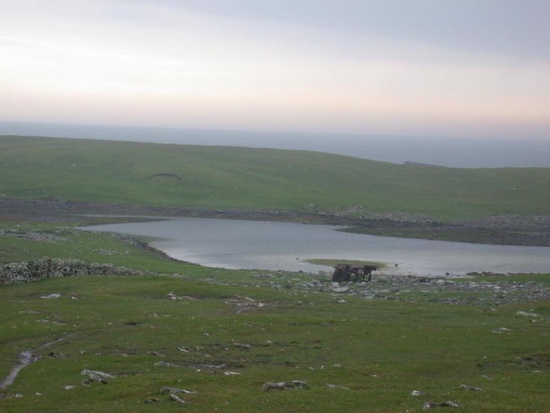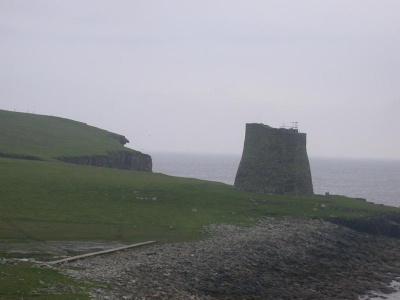m (Mousa Shetland moved to Mousa: title format) |
|||
| (5 intermediate revisions by 3 users not shown) | |||
| Line 1: | Line 1: | ||
| − | {{ | + | {{incompletelocation}} |
| − | [[Image:Mousa Lochan bf.jpg|thumb|550px|right|Photo by Delia Todd<br />A view of the lochan on Mousa]] | + | [[Image:Mousa Lochan bf.jpg|thumb|550px|right|Photo by {{user|delia+todd|Delia Todd}}<br />A view of the lochan on Mousa]] |
[[Scotland]] | [[Scotland]] | ||
| Line 10: | Line 10: | ||
==Birds== | ==Birds== | ||
===Notable Species=== | ===Notable Species=== | ||
| − | There is a large [[European Storm-petrel]] colony on Mousa numbering more than 6000 pairs many of which breed in and around the ancient stone walls. Other breeding seabirds include [[Northern Fulmar]], [[Great Skua]] and [[Arctic Skua]], [[European Shag|Shag]], [[Black Guillemot]] and nationally important numbers of [[Arctic Tern]]. The island also has breeding [[Common Eider]] and a few waders. The pools may attract a few passage waders and in winter [[Long-tailed Duck]] can be seen in good numbers. [[King Eider]] has been seen here with some regularity. | + | There is a large [[European Storm-petrel]] colony on Mousa numbering more than 6000 pairs many of which breed in and around the ancient stone walls. |
| + | |||
| + | Other breeding seabirds include [[Northern Fulmar]], [[Great Skua]] and [[Arctic Skua]], [[European Shag|Shag]], [[Black Guillemot]] and nationally important numbers of [[Arctic Tern]]. The island also has breeding [[Common Eider]] and a few waders. | ||
| + | |||
| + | The pools may attract a few passage waders and in winter [[Long-tailed Duck]] can be seen in good numbers. [[King Eider]] has been seen here with some regularity. | ||
===Check-list=== | ===Check-list=== | ||
| − | {{BirdsSee|[[Northern Fulmar]], [[European Storm-petrel]], [[European Shag]], [[Common Eider]], [[King Eider]], [[Long-tailed Duck]], [[Great Skua]], [[Arctic Skua]], [[Arctic Tern]], [[Black Guillemot]]}} | + | {{BirdsSee|[[Northern Fulmar]], [[European Storm-petrel]], [[European Shag]], [[Common Eider]], [[King Eider]], [[Long-tailed Duck]], [[Rock Pigeon]], [[Red-throated Diver]], [[Eurasian Oystercatcher]], [[Common Ringed Plover]], [[Dunlin]], [[Ruddy Turnstone]], [[Common Snipe]], [[Common Redshank]], [[Great Skua]], [[Arctic Skua]], [[Arctic Tern]], [[Common Guillemot]], [[Black Guillemot]], [[Hooded Crow]]}} |
==Other Wildlife== | ==Other Wildlife== | ||
| Line 22: | Line 26: | ||
===History and Use=== | ===History and Use=== | ||
| − | [[Image:Mousa Broch6 bf.jpg|thumb|400px|right|Photo by Delia Todd<br />Mousa Broch]] | + | [[Image:Mousa Broch6 bf.jpg|thumb|400px|right|Photo by {{user|delia+todd|Delia Todd}}<br />Mousa Broch]] |
Mousa is famous as the site of a well-preserved Iron Age Pictish broch. | Mousa is famous as the site of a well-preserved Iron Age Pictish broch. | ||
| Line 30: | Line 34: | ||
===Access and Facilities=== | ===Access and Facilities=== | ||
Mousa can only be reached by boat from Leebitton on the south-east coast of Mainland, Shetland. Local boatmen arrange trips to the island including overnight stays, essential to see the storm-petrels. | Mousa can only be reached by boat from Leebitton on the south-east coast of Mainland, Shetland. Local boatmen arrange trips to the island including overnight stays, essential to see the storm-petrels. | ||
| + | |||
| + | Grid reference: HU435248 | ||
===Contact Details=== | ===Contact Details=== | ||
| − | + | Tel: 01950 460800 | |
==External Links== | ==External Links== | ||
| − | + | *[http://www.rspb.org.uk/reserves/guide/m/mousa/index.asp RSPB Mousa] | |
| + | *[http://www.streetmap.co.uk/idmap.srf?x=443550&y=1124850&z=126&sv=443550,1124850&st=4&ar=Y&mapp=idmap.srf&searchp=ids.srf&ax=443550&ay=1124850&lm=0 Mousa on Streetmap] | ||
''Content and images originally posted by Steve'' | ''Content and images originally posted by Steve'' | ||
<!-- --> | <!-- --> | ||
| − | [[Category:Shetland]] [[Category:Locations]] | + | [[Category:Shetland]] [[Category:Locations]][[Category:RSPB]] [[Category:Scotland]] |
Latest revision as of 12:09, 29 April 2020
| This article is incomplete. This article is missing one or more sections. You can help the BirdForum Opus by expanding it. |
Overview
Lying less than 1km off the east coast of Mainland, Shetland, the small and low-lying island of Mousa consists of rough grassland and heath with small areas of marsh. In addition there are some small lochs and tidal pools.
It is one of the smaller and most attractive of the Shetland Islands with it's well known as its seabird colonies and is relatively accessible.
Birds
Notable Species
There is a large European Storm-petrel colony on Mousa numbering more than 6000 pairs many of which breed in and around the ancient stone walls.
Other breeding seabirds include Northern Fulmar, Great Skua and Arctic Skua, Shag, Black Guillemot and nationally important numbers of Arctic Tern. The island also has breeding Common Eider and a few waders.
The pools may attract a few passage waders and in winter Long-tailed Duck can be seen in good numbers. King Eider has been seen here with some regularity.
Check-list
Birds you can see here include:
Northern Fulmar, European Storm-petrel, European Shag, Common Eider, King Eider, Long-tailed Duck, Rock Pigeon, Red-throated Diver, Eurasian Oystercatcher, Common Ringed Plover, Dunlin, Ruddy Turnstone, Common Snipe, Common Redshank, Great Skua, Arctic Skua, Arctic Tern, Common Guillemot, Black Guillemot, Hooded Crow
Other Wildlife
Common Seal Phoca vitulina breeds on the island in substantial numbers and Grey Seal Halichoerus grypus can also be seen. Regular cetaceans include Minke Whale Balaenoptera acutorostrata, Killer Whale Orcinus orca and Common Porpoise Phocoena phocoena. Otter Lutra lutra can also be seen.
Site Information
History and Use
Mousa is famous as the site of a well-preserved Iron Age Pictish broch.
Areas of Interest
To do
Access and Facilities
Mousa can only be reached by boat from Leebitton on the south-east coast of Mainland, Shetland. Local boatmen arrange trips to the island including overnight stays, essential to see the storm-petrels.
Grid reference: HU435248
Contact Details
Tel: 01950 460800
External Links
Content and images originally posted by Steve





